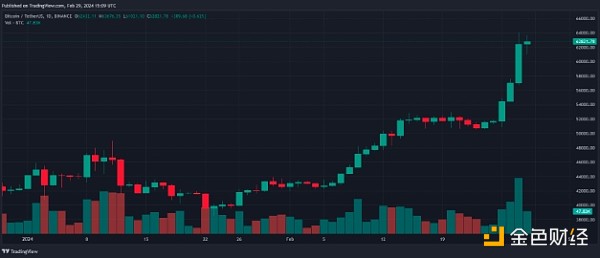Author: Zoltan Vardai, CoinTelegraph; Compiled by: Deng Tong, Golden Finance
Bitcoin’s four-year halving cycle is widely associated with subsequent cryptocurrency market bull markets, which typically lead to Bitcoin’s record high New all-time high. But is the long-awaited halving the right time to invest in the world’s largest cryptocurrency?
K33 Research senior analyst Vetle Lunde said, Based on historical Bitcoin price data, for investors with a longer view, the halving may be a good time to buy: “Although the halving Performance tends to be lackluster, but each halving has proven to be a solid point of entry into the market. Halving The last 150-400 days are often the best time. The compound effect of the weakening selling pressure on miners has a positive impact on BTC."
February 28, before the halving In 47 days, Bitcoin has surpassed the $60,000 mark for the first time in more than two years, while the world's first cryptocurrency has gained 30% in the past week.
The Bitcoin halving halves the rate at which new Bitcoins are issued and circulated every four years. By 2140, the year of the last Bitcoin halving, the network will stop producing new Bitcoins once it reaches 21 million.

BTC/USD year-to-date chart. Source: CoinMarketCap
Hectic Labs investor and CEO Bryan Legend said theperiod leading up to the halving could be a favorable time to own Bitcoin. He pointed out: “The actual halving event before the halving is a good time to realize gains. The rebound before the halving will Investor sentiment shifts to new bull cycle, but timing the market to know when to top out is challenging."
Bitcoin rises to $67,611 before halving mark, largely due to record inflows into 10 new spot Bitcoin exchange-traded funds (ETFs) in the United States. CoinShares analyst James Butterfill said, "After the recent price increase, total assets under management (AuM) are now very close to an all-time high of $82.6 billion, only slightly lower than the $86 billion peak set in early November."
Bitcoin accounted for "94% of inflows" at $1.72 billion, while U.S. funds continued to dominate with net inflows of $1.88 billion, the report said.
Sergei Gorev, risk manager at fintech platform YouHodler, said that inflows into Bitcoin ETFs and anticipation ahead of the halving are a big part of the current rally. He said: “Spot Bitcoin ETFs buy 10 times the number of Bitcoins per day that miners produce per day. ."
Can the price of Bitcoin reach $120,000 by the end of 2024?
K33 Research’s Lunde said, Bitcoin prices typically rebound around halvings; A consolidation will occur immediately. He said:
“The pre-halving rally stems from a combination of traders buying in early and miners holding the majority of the rewards. After the halving, the computing power tends to decline. plunge, block production will stall for 10 minutes to 15-25 minutes, leading to increased uncertainty."
However, Lunde predicts, There will only be a brief correction before Bitcoin prices return to new all-time highs.
“Based purely on past performance data and the diminishing impact of the halving rally,Bitcoin could rise 130-150% in the year after the halving, which would lead to a peak of $125,000-$150,000 in 2025."
< img src="https://img.jinse.cn/7186465_watermarknone.png" title="7186465" alt="9SpDJN3KhYUVlfa0l3l4CFjDqHxNVQqhs7eQwyGL.jpeg">
Historical Bitcoin chart, including halvings. Source: Bitbo
Hectic Labs CEO Bryan Legend said, In the worst case scenario , Bitcoin’s year-end price could reach around $80,000 to $85,000, and $120,000 to $130,000 in a bullish scenario. He pointed out that this mainly depends on macroeconomic conditions:
"[2025 2025 bull market] will depend on financial market conditions and the outlook for world fundamentals... If the bull market does continue into 2025, we may indeed see higher prices, with BTC as high as $180,000-$200,000."
 JinseFinance
JinseFinance



